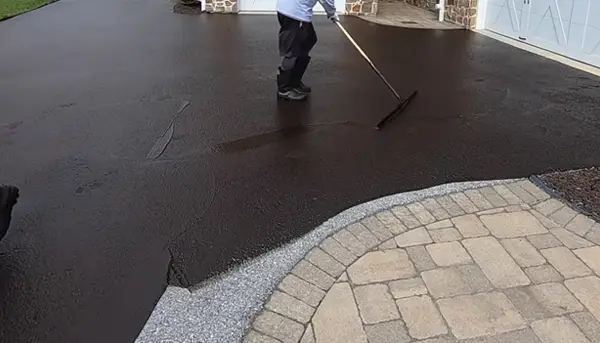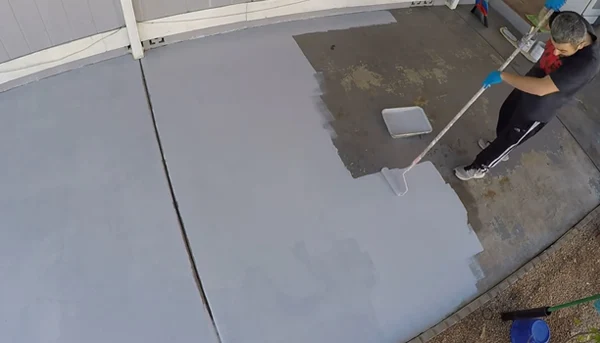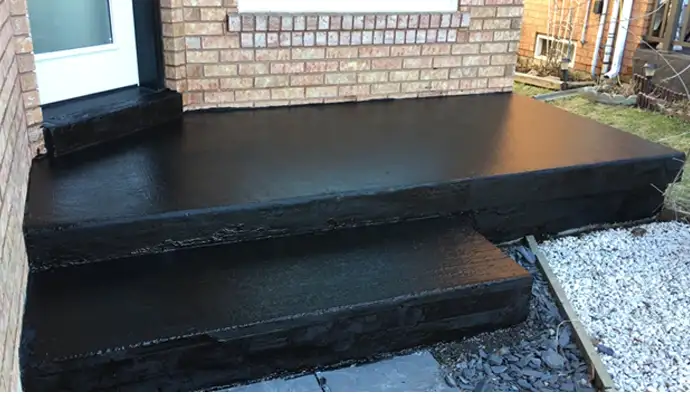Last Updated on January 18, 2023
Asphalt sealer is a popular choice for many homeowners and businesses due to its cost-effectiveness, durability, and aesthetically pleasing finish. But it is often not known whether asphalt sealer can be applied over concrete surfaces.
This article will explore the reasons why applying asphalt sealer over concrete may be beneficial, potential negative issues that could arise from doing so, and tips on how to properly prepare the surface before application.
We will also discuss the definition of both concrete and asphalt sealers in order to gain a better understanding of what each material offers.
Can You Put Asphalt Sealer over Concrete?

The short answer to this question is yes, you can put asphalt sealer over concrete. There are a few considerations to make when doing so, however. For example, the concrete must be fully cured and should have no cracks or gaps that could allow water to seep in.
Additionally, the concrete will need to be cleaned of any dirt or debris prior to the application of an asphalt sealer. Furthermore, a primer may need to be applied prior to sealing with asphalt for a better bond between the two surfaces.
When applying asphalt sealer over concrete, it is important to choose one that is specifically designed for this purpose.
Water-based and solvent-based asphalt sealers are available; water-based versions tend to be more durable and provide better protection against moisture damage while offering less smell and fumes than solvent-based products.
It’s also important to ensure that the surface has been properly prepped before applying any type of sealant; otherwise, adhesion issues may occur down the line. Finally, the temperature should be above 50°F (10°C) during application as this ensures proper drying time and curing of the sealant.
Definition of Concrete and Asphalt Sealer
Applying asphalt sealer to concrete surfaces can offer a variety of benefits, but it is important to understand the potential drawbacks before making a decision.
This article will discuss the reasons for applying asphalt sealer over concrete, the potential issues that may arise, and the steps necessary to ensure that the process is successful.
Reasons for Applying Asphalt Sealer Over Concrete:
Protection from Debris, Moisture, and Chemicals:
Applying asphalt sealer over concrete provides a protective layer against debris, moisture, and chemicals. It helps protect against cracks in the concrete due to temperature changes and other external forces.
The sealant also prevents water from seeping into the concrete itself and damaging it. Additionally, asphalt sealer prevents chemicals such as paint or oil from staining the surface of the concrete.
Increased Aesthetic Value and Durability:
Applying an asphalt sealant will increase both aesthetic value and durability of your property’s concrete surfaces. Depending on the type of sealant used, you can expect added sheen or a smoother finish on your exterior surfaces. Furthermore, this protective coating adds an extra layer of protection against weathering and general wear-and-tear of your property’s exterior surfaces.
Cost Savings Compared to Replacing the Concrete:
Finally, applying an asphalt sealant is generally much more cost effective than replacing large sections of your property’s outdoor area with new concrete or other materials. In most cases this will also be faster than tearing out damaged portions of your outdoor area just to replace them with new materials especially when extensive repairs are needed after major damage has already been done by weather or time.
Potential Negative Issues When Applying Asphalt Sealer Over Concrete:

Cracks in the Concrete Could Lead to Future Damage or Deterioration of Sealant Coating:
Before applying any kind of asphalt sealant to existing concrete surfaces it is important to check for any cracks in that surface first. If there are any existing cracks then they should be properly filled in prior to application so as not to cause future damage or deterioration of the applied sealant coating once it is applied atop them.
Adhesion Issues Leading to Poor Bond Between Two Surfaces:
Another issue that may arise when applying asphalt sealer atop existing concrete surfaces is poor adhesion between these two different surfaces leading to a weak bond between them once sealed together.
To prevent this from happening you must ensure that all areas where you plan on applying asphalt sealant are properly cleaned before doing so removing dirt particles and debris which could prevent proper adhesion from happening when applied atop those areas afterward.
Imbalance in Temperature May Cause Shrinking or Expansion of Asphalt Sealant:
Lastly, extreme temperatures can cause imbalance amongst various parts of your outdoor space leading to either shrinking or expansion depending on which direction these temperatures swing towards; this could cause cracking within newly sealed areas if not monitored closely enough resulting in further damage needing repair down the line later on after application has taken place again emphasizing why proper preparation before application needs thorough consideration first.
Preparing the Surface Before Applying Asphalt Sealer Over Concrete:
First and foremost, any debris or dirt must be removed from the surface of the concrete using either a pressure washer or a stiff-bristled broom. Additionally, any cracks or holes in the surface must be filled with sand and cement mixture for added strength and stability.
Lastly, it’s important to apply a bonding agent to ensure that a proper adhesion is created between the asphalt sealer and the concrete beneath it.
Cleaning off Debris From Surface of Concrete with Pressure Washer or Broom:
The most effective way to remove dirt, dust, debris, and other contaminants from the surface of concrete prior to applying asphalt sealer is by using either a pressure washer or a stiff-bristled broom.
When using a pressure washer, make sure not to spray too close to the surface of the concrete as this could cause damage. For best results, begin spraying at least 8 feet away from the surface before gradually moving closer until all dirt has been removed.
Filling Any Cracks or Holes with Sand and Cement Mixture:
Filling any cracks or holes in the surface of your concrete before applying asphalt sealer is extremely important for both creating an even finish on your driveway or other area and for keeping water out that could otherwise cause serious damage if allowed into crevices in your driveway’s foundation.
To do this properly mix equal parts sand with equal parts Portland cement in order create an appropriate filler mixture which can then be packed into any gaps on your driveways surface using either a trowel or your hands depending on size/depth of crack.
Applying Bonding Agent to Ensure Proper Adhesion Between Surfaces:
Once all debris has been removed from your driveway’s surface and all cracks have been filled it is important to then apply an appropriate bonding agent prior to applying asphalt sealant so that you can ensure proper adhesion between these two surfaces will occur once applied properly following manufacturer’s directions accordingly.
Most bonding agents are simple mixes of dish soap (or liquid soap) mixed with water which should be thoroughly wiped across whatever area(s) you plan on applying asphalt sealant onto in order to ensure perfect adhesion between these two surfaces before beginning sealing process itself.
Applying The Asphalt Sealer Over Unprepared Concrete Surface:
Now that we have discussed how best prepare our concrete before applying asphalt sealant let’s now look at exactly how one applies this product in order get desired finished product while also ensuring durability/stability over time period expected from such product being used correctly & appropriately according manufacturer’s instructions given when purchased product itself.
Mixing Up Product According To Manufacturer’s Directions:
It is essential that one follows manufacturer’s directions when mixing up their product prior application onto desired surfaces as this will help ensure best possible results are achieved during use while also helping keep user safe during entire process as well due potential hazardous materials contained within certain types products used today depending which one chosen fit individual project being completed at time given moment/circumstance being faced while completing said task/project etc.
Painting On Thin Layer Of Asphalt Sealant With Brush Or Roller:
After mixing up product according manufacturer’s directions it imperative next step involves painting thin layer asphalt sealant onto desired areas via brush roller making sure avoid spreading too much excess material around avoiding having take corrective action such scraping off excessive amounts coating changing other aspects original plan if done improperly etc.
Allowing Appropriate Curing Time Before Using Surface Or Driving On It:
Final step involved completing job successfully allowing sufficient amount curing time after completion job in order give newly applied material opportunity achieve maximal success ensuring everything looks accordance expectations had going into project becoming reality desired outcome achieved due diligence put forth following manufacturers instructions closely throughout entire process producing excellent result come end day.
Is it Worth Sealing Old Concrete?
Yes, sealing old concrete can provide numerous benefits, including protecting underlying surfaces from damage due to moisture infiltration or contact with other substances such as oil or chemicals.
Additionally, sealing can help prevent staining from spills or direct contact with these materials and enhance resistance against freeze/thaw cycles which can cause cracking in porous materials such as concrete. Sealing can also reduce dusting by helping holding fine particles together which prevents them from being displaced when disturbed by foot traffic or cleaning steps like sweeping or mopping.
Finally, sealing old concrete can enhance its appearance by providing a glossy finish which improves visual appeal while helping reduce slipperiness on surfaces like walkways and driveways where water might pool after rain showers or snowmelts occur. This makes them safer for foot traffic as well as providing an aesthetically pleasing look when looking at them from afar.
How Long Does Asphalt Concrete Last?
Asphalt concrete typically lasts anywhere between 15-25 years depending on environmental conditions such as rainfall frequency and severity as well as how much foot traffic it receives on a regular basis.
The lifespan of an asphalt pavement can also depend on whether it was properly constructed with sufficient compaction before its installation; this will help ensure better long-term performance even under heavy usage from vehicles driving over it frequently or exposure to harsh weather elements like extreme cold temperatures or large amounts of precipitation in a given season.
In terms of maintenance for asphalt concrete pavements, sealcoating every 4-5 years is generally recommended in order to extend their lifespan significantly since this helps protect against erosion caused by vehicle tires and inclement weather conditions alike while enhancing overall aesthetics through its glossy finish which helps improve curb appeal as well!
Additionally, repairing cracks and potholes in a timely manner when they do appear is critical for preventing further deterioration since these defects can lead to bigger issues down the line if left unaddressed so performing regular inspections should be part of any routine maintenance regimen associated with maintaining an asphalt pavement’s longevity!
Conclusion
Applying an asphalt sealer over a concrete surface can offer many advantages if done correctly. It provides protection from debris, moisture, and chemicals, increases aesthetic value and durability, as well as saves money compared to replacing the concrete.
However, it is important to remember that there are potential negative issues to consider when applying asphalt sealer over concrete such as cracks in the concrete leading to future damage or deterioration of the sealant coating.
Additionally, proper preparation is essential in order for the bond between the two surfaces to be successful. Ultimately, with careful consideration of these factors one can determine if applying an asphalt sealer over a concrete surface is right for their particular situation.


